Bo Fang
ScSAM: Debiasing Morphology and Distributional Variability in Subcellular Semantic Segmentation
Jul 23, 2025Abstract:The significant morphological and distributional variability among subcellular components poses a long-standing challenge for learning-based organelle segmentation models, significantly increasing the risk of biased feature learning. Existing methods often rely on single mapping relationships, overlooking feature diversity and thereby inducing biased training. Although the Segment Anything Model (SAM) provides rich feature representations, its application to subcellular scenarios is hindered by two key challenges: (1) The variability in subcellular morphology and distribution creates gaps in the label space, leading the model to learn spurious or biased features. (2) SAM focuses on global contextual understanding and often ignores fine-grained spatial details, making it challenging to capture subtle structural alterations and cope with skewed data distributions. To address these challenges, we introduce ScSAM, a method that enhances feature robustness by fusing pre-trained SAM with Masked Autoencoder (MAE)-guided cellular prior knowledge to alleviate training bias from data imbalance. Specifically, we design a feature alignment and fusion module to align pre-trained embeddings to the same feature space and efficiently combine different representations. Moreover, we present a cosine similarity matrix-based class prompt encoder to activate class-specific features to recognize subcellular categories. Extensive experiments on diverse subcellular image datasets demonstrate that ScSAM outperforms state-of-the-art methods.
Threading Keyframe with Narratives: MLLMs as Strong Long Video Comprehenders
May 30, 2025Abstract:Employing Multimodal Large Language Models (MLLMs) for long video understanding remains a challenging problem due to the dilemma between the substantial number of video frames (i.e., visual tokens) versus the limited context length of language models. Traditional uniform sampling often leads to selection of irrelevant content, while post-training MLLMs on thousands of frames imposes a substantial computational burden. In this paper, we propose threading keyframes with narratives (Nar-KFC), a plug-and-play module to facilitate effective and efficient long video perception. Nar-KFC generally involves two collaborative steps. First, we formulate the keyframe selection process as an integer quadratic programming problem, jointly optimizing query-relevance and frame-diversity. To avoid its computational complexity, a customized greedy search strategy is designed as an efficient alternative. Second, to mitigate the temporal discontinuity caused by sparse keyframe sampling, we further introduce interleaved textual narratives generated from non-keyframes using off-the-shelf captioners. These narratives are inserted between keyframes based on their true temporal order, forming a coherent and compact representation. Nar-KFC thus serves as a temporal- and content-aware compression strategy that complements visual and textual modalities. Experimental results on multiple long-video benchmarks demonstrate that Nar-KFC significantly improves the performance of popular MLLMs. Code will be made publicly available.
Can Large Language Models Understand Intermediate Representations?
Feb 07, 2025Abstract:Intermediate Representations (IRs) are essential in compiler design and program analysis, yet their comprehension by Large Language Models (LLMs) remains underexplored. This paper presents a pioneering empirical study to investigate the capabilities of LLMs, including GPT-4, GPT-3, Gemma 2, LLaMA 3.1, and Code Llama, in understanding IRs. We analyze their performance across four tasks: Control Flow Graph (CFG) reconstruction, decompilation, code summarization, and execution reasoning. Our results indicate that while LLMs demonstrate competence in parsing IR syntax and recognizing high-level structures, they struggle with control flow reasoning, execution semantics, and loop handling. Specifically, they often misinterpret branching instructions, omit critical IR operations, and rely on heuristic-based reasoning, leading to errors in CFG reconstruction, IR decompilation, and execution reasoning. The study underscores the necessity for IR-specific enhancements in LLMs, recommending fine-tuning on structured IR datasets and integration of explicit control flow models to augment their comprehension and handling of IR-related tasks.
PrisonBreak: Jailbreaking Large Language Models with Fewer Than Twenty-Five Targeted Bit-flips
Dec 10, 2024



Abstract:We introduce a new class of attacks on commercial-scale (human-aligned) language models that induce jailbreaking through targeted bitwise corruptions in model parameters. Our adversary can jailbreak billion-parameter language models with fewer than 25 bit-flips in all cases$-$and as few as 5 in some$-$using up to 40$\times$ less bit-flips than existing attacks on computer vision models at least 100$\times$ smaller. Unlike prompt-based jailbreaks, our attack renders these models in memory 'uncensored' at runtime, allowing them to generate harmful responses without any input modifications. Our attack algorithm efficiently identifies target bits to flip, offering up to 20$\times$ more computational efficiency than previous methods. This makes it practical for language models with billions of parameters. We show an end-to-end exploitation of our attack using software-induced fault injection, Rowhammer (RH). Our work examines 56 DRAM RH profiles from DDR4 and LPDDR4X devices with different RH vulnerabilities. We show that our attack can reliably induce jailbreaking in systems similar to those affected by prior bit-flip attacks. Moreover, our approach remains effective even against highly RH-secure systems (e.g., 46$\times$ more secure than previously tested systems). Our analyses further reveal that: (1) models with less post-training alignment require fewer bit flips to jailbreak; (2) certain model components, such as value projection layers, are substantially more vulnerable than others; and (3) our method is mechanistically different than existing jailbreaks. Our findings highlight a pressing, practical threat to the language model ecosystem and underscore the need for research to protect these models from bit-flip attacks.
DistinctAD: Distinctive Audio Description Generation in Contexts
Nov 27, 2024



Abstract:Audio Descriptions (ADs) aim to provide a narration of a movie in text form, describing non-dialogue-related narratives, such as characters, actions, or scene establishment. Automatic generation of ADs remains challenging due to: i) the domain gap between movie-AD data and existing data used to train vision-language models, and ii) the issue of contextual redundancy arising from highly similar neighboring visual clips in a long movie. In this work, we propose DistinctAD, a novel two-stage framework for generating ADs that emphasize distinctiveness to produce better narratives. To address the domain gap, we introduce a CLIP-AD adaptation strategy that does not require additional AD corpora, enabling more effective alignment between movie and AD modalities at both global and fine-grained levels. In Stage-II, DistinctAD incorporates two key innovations: (i) a Contextual Expectation-Maximization Attention (EMA) module that reduces redundancy by extracting common bases from consecutive video clips, and (ii) an explicit distinctive word prediction loss that filters out repeated words in the context, ensuring the prediction of unique terms specific to the current AD. Comprehensive evaluations on MAD-Eval, CMD-AD, and TV-AD benchmarks demonstrate the superiority of DistinctAD, with the model consistently outperforming baselines, particularly in Recall@k/N, highlighting its effectiveness in producing high-quality, distinctive ADs.
Final Report for CHESS: Cloud, High-Performance Computing, and Edge for Science and Security
Oct 21, 2024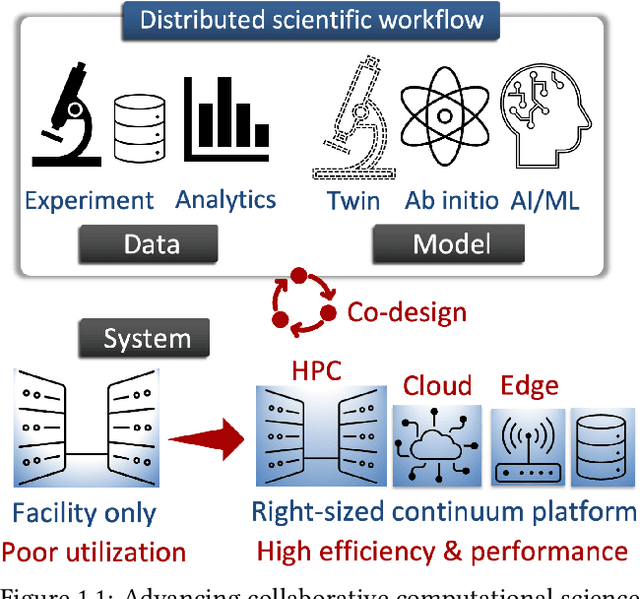
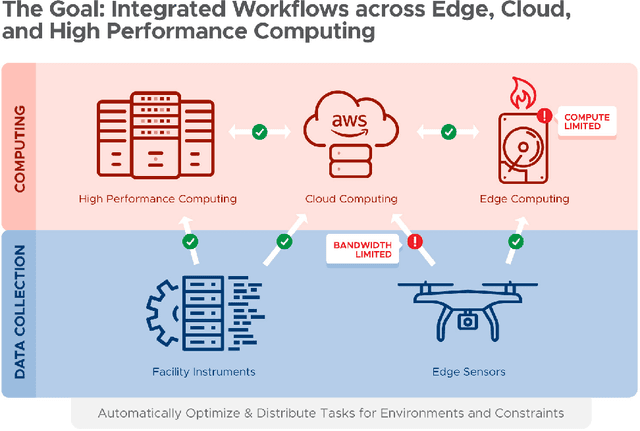
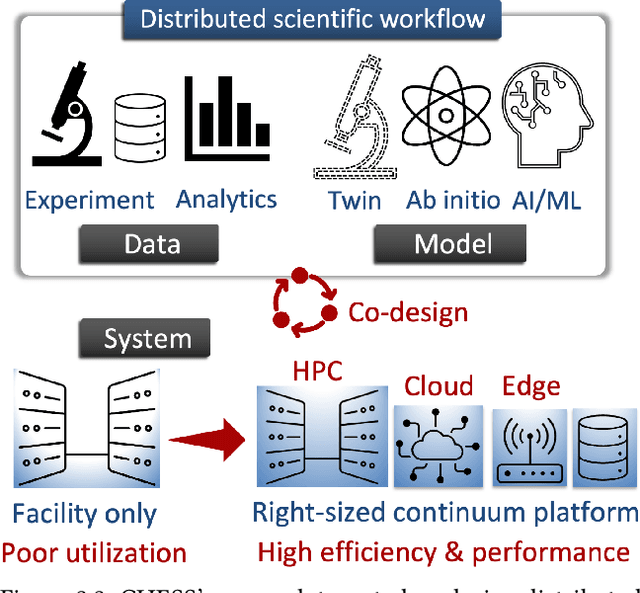

Abstract:Automating the theory-experiment cycle requires effective distributed workflows that utilize a computing continuum spanning lab instruments, edge sensors, computing resources at multiple facilities, data sets distributed across multiple information sources, and potentially cloud. Unfortunately, the obvious methods for constructing continuum platforms, orchestrating workflow tasks, and curating datasets over time fail to achieve scientific requirements for performance, energy, security, and reliability. Furthermore, achieving the best use of continuum resources depends upon the efficient composition and execution of workflow tasks, i.e., combinations of numerical solvers, data analytics, and machine learning. Pacific Northwest National Laboratory's LDRD "Cloud, High-Performance Computing (HPC), and Edge for Science and Security" (CHESS) has developed a set of interrelated capabilities for enabling distributed scientific workflows and curating datasets. This report describes the results and successes of CHESS from the perspective of open science.
Light-Weight Fault Tolerant Attention for Large Language Model Training
Oct 15, 2024



Abstract:Large Language Models (LLMs) have demonstrated remarkable performance in various natural language processing tasks. However, the training of these models is computationally intensive and susceptible to faults, particularly in the attention mechanism, which is a critical component of transformer-based LLMs. In this paper, we investigate the impact of faults on LLM training, focusing on INF, NaN, and near-INF values in the computation results with systematic fault injection experiments. We observe the propagation patterns of these errors, which can trigger non-trainable states in the model and disrupt training, forcing the procedure to load from checkpoints.To mitigate the impact of these faults, we propose ATTNChecker, the first Algorithm-Based Fault Tolerance (ABFT) technique tailored for the attention mechanism in LLMs. ATTNChecker is designed based on fault propagation patterns of LLM and incorporates performance optimization to adapt to both system reliability and model vulnerability while providing lightweight protection for fast LLM training. Evaluations on four LLMs show that ATTNChecker on average incurs on average 7% overhead on training while detecting and correcting all extreme errors. Compared with the state-of-the-art checkpoint/restore approach, ATTNChecker reduces recovery overhead by up to 49x.
UATVR: Uncertainty-Adaptive Text-Video Retrieval
Jan 16, 2023Abstract:With the explosive growth of web videos and emerging large-scale vision-language pre-training models, e.g., CLIP, retrieving videos of interest with text instructions has attracted increasing attention. A common practice is to transfer text-video pairs to the same embedding space and craft cross-modal interactions with certain entities in specific granularities for semantic correspondence. Unfortunately, the intrinsic uncertainties of optimal entity combinations in appropriate granularities for cross-modal queries are understudied, which is especially critical for modalities with hierarchical semantics, e.g., video, text, etc. In this paper, we propose an Uncertainty-Adaptive Text-Video Retrieval approach, termed UATVR, which models each look-up as a distribution matching procedure. Concretely, we add additional learnable tokens in the encoders to adaptively aggregate multi-grained semantics for flexible high-level reasoning. In the refined embedding space, we represent text-video pairs as probabilistic distributions where prototypes are sampled for matching evaluation. Comprehensive experiments on four benchmarks justify the superiority of our UATVR, which achieves new state-of-the-art results on MSR-VTT (50.8%), VATEX (64.5%), MSVD (49.7%), and DiDeMo (45.8%). The code is available in supplementary materials and will be released publicly soon.
Cap4Video: What Can Auxiliary Captions Do for Text-Video Retrieval?
Dec 31, 2022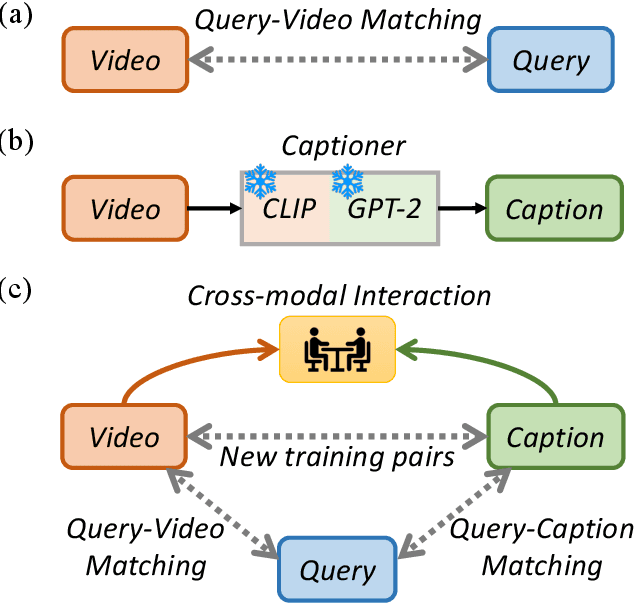
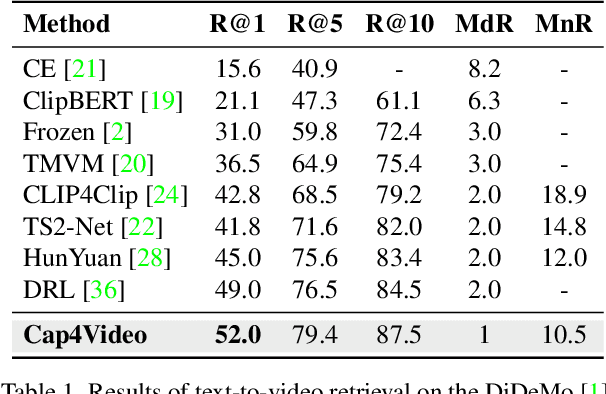
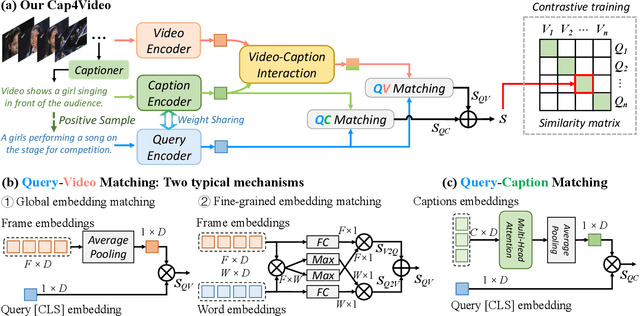
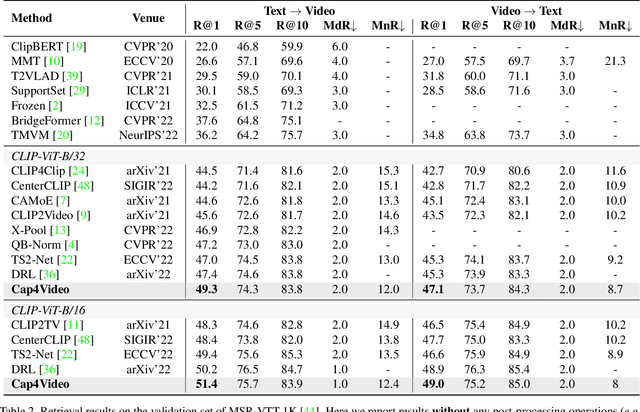
Abstract:Most existing text-video retrieval methods focus on cross-modal matching between the visual content of offline videos and textual query sentences. However, in real scenarios, online videos are frequently accompanied by relevant text information such as titles, tags, and even subtitles, which can be utilized to match textual queries. This inspires us to generate associated captions from offline videos to help with existing text-video retrieval methods. To do so, we propose to use the zero-shot video captioner with knowledge of pre-trained web-scale models (e.g., CLIP and GPT-2) to generate captions for offline videos without any training. Given the captions, one question naturally arises: what can auxiliary captions do for text-video retrieval? In this paper, we present a novel framework Cap4Video, which makes use of captions from three aspects: i) Input data: The video and captions can form new video-caption pairs as data augmentation for training. ii) Feature interaction: We perform feature interaction between video and caption to yield enhanced video representations. iii) Output score: The Query-Caption matching branch can be complementary to the original Query-Video matching branch for text-video retrieval. We conduct thorough ablation studies to demonstrate the effectiveness of our method. Without any post-processing, our Cap4Video achieves state-of-the-art performance on MSR-VTT (51.4%), VATEX (66.6%), MSVD (51.8%), and DiDeMo (52.0%).
Video 3D Sampling for Self-supervised Representation Learning
Jul 08, 2021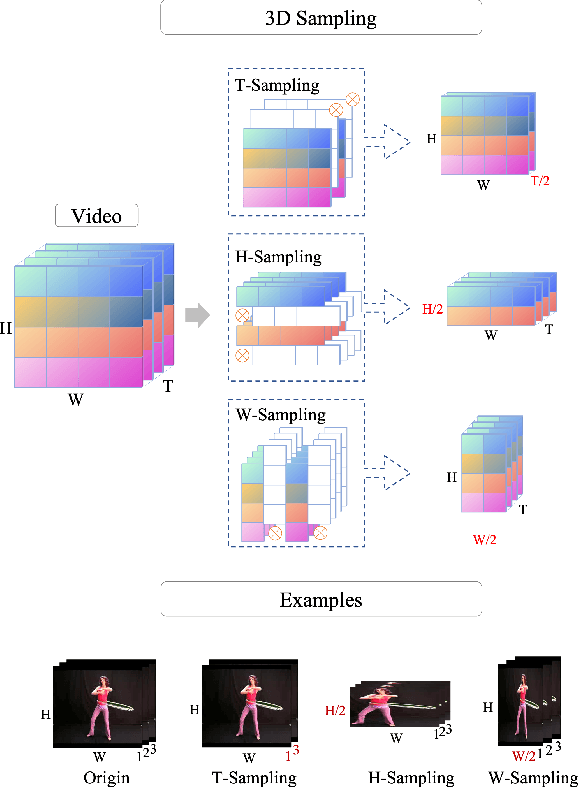
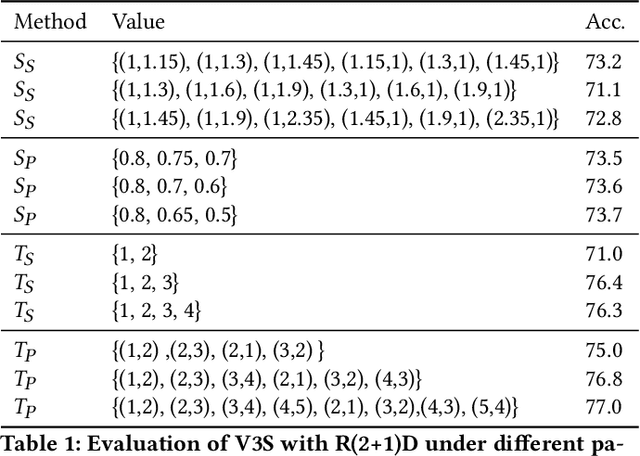

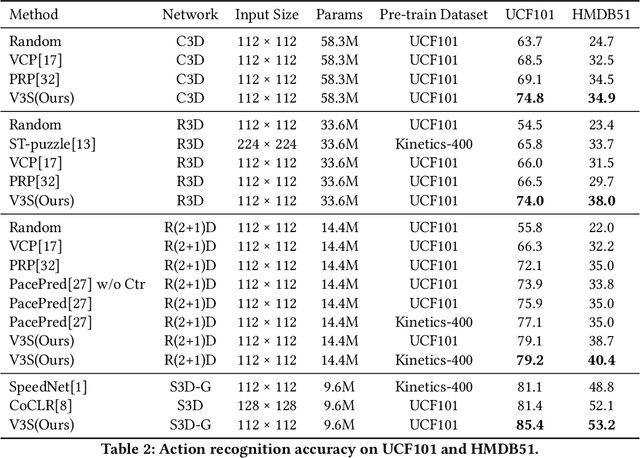
Abstract:Most of the existing video self-supervised methods mainly leverage temporal signals of videos, ignoring that the semantics of moving objects and environmental information are all critical for video-related tasks. In this paper, we propose a novel self-supervised method for video representation learning, referred to as Video 3D Sampling (V3S). In order to sufficiently utilize the information (spatial and temporal) provided in videos, we pre-process a video from three dimensions (width, height, time). As a result, we can leverage the spatial information (the size of objects), temporal information (the direction and magnitude of motions) as our learning target. In our implementation, we combine the sampling of the three dimensions and propose the scale and projection transformations in space and time respectively. The experimental results show that, when applied to action recognition, video retrieval and action similarity labeling, our approach improves the state-of-the-arts with significant margins.
 Add to Chrome
Add to Chrome Add to Firefox
Add to Firefox Add to Edge
Add to Edge